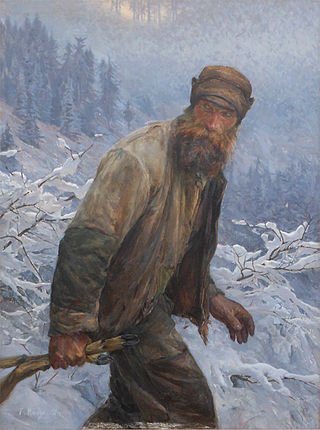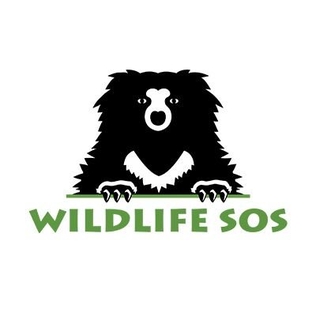Related Research Articles

Ivory is a hard, white material from the tusks and teeth of animals, that consists mainly of dentine, one of the physical structures of teeth and tusks. The chemical structure of the teeth and tusks of mammals is the same, regardless of the species of origin, but ivory contains structures of mineralised collagen. The trade in certain teeth and tusks other than elephant is well established and widespread; therefore, "ivory" can correctly be used to describe any mammalian teeth or tusks of commercial interest which are large enough to be carved or scrimshawed.

Poaching is the illegal hunting or capturing of wild animals, usually associated with land use rights. Poaching was once performed by impoverished peasants for subsistence purposes and to supplement meager diets. It was set against the hunting privileges of nobility and territorial rulers.

The African forest elephant is one of the two living species of African elephant. It is native to humid tropical forests in West Africa and the Congo Basin. It is the smallest of the three living elephant species, reaching a shoulder height of 2.4 m. As with other African elephants, both sexes have straight, down-pointing tusks, which begin to grow once the animals reach 1–3 years old. The forest elephant lives in highly sociable family groups of up to 20 individuals. Since they forage primarily on leaves, seeds, fruit, and tree bark, they have often been referred to as the 'megagardener of the forest'; the species is one of many that contributes significantly to maintaining the composition, diversity and structure of the Guinean Forests of West Africa and the Congolese rainforests. Seeds of various plants will go through the elephant's digestive tract and eventually pass through in the animal's droppings, thus helping to maintain the spread and biodiversity of the forests.

Garamba National Park is a national park in the north-eastern Democratic Republic of the Congo covering nearly 5,200 km2 (2,000 sq mi). It is among Africa's oldest parks and was designated a World Heritage Site by UNESCO in 1980 for its protection of critical habitat for northern white rhinoceroses, African elephants, hippopotamuses, and giraffes. Garamba National Park has been managed by African Parks in partnership with the Institut Congolais pour la Conservation de la Nature since 2005.

Environmental issues in Kenya include deforestation, soil erosion, desertification, water shortage and degraded water quality, flooding, poaching, and domestic and industrial pollution.

The Wildlife Trust of India is an Indian nature conservation organisation under Ministry of Forest Department, Government of India.

Wildlife trade refers to the products that are derived from non-domesticated animals or plants usually extracted from their natural environment or raised under controlled conditions. It can involve the trade of living or dead individuals, tissues such as skins, bones or meat, or other products. Legal wildlife trade is regulated by the United Nations' Convention on International Trade in Endangered Species of Wild Fauna and Flora (CITES), which currently has 184 member countries called Parties. Illegal wildlife trade is widespread and constitutes one of the major illegal economic activities, comparable to the traffic of drugs and weapons.

The Wildlife Protection Society of India (WPSI) was founded in 1994 by Belinda Wright, its Executive Director, who was an award-winning wildlife photographer and filmmaker till she took up the cause of conservation. From its inception, WPSI's main aim has been to bring a new focus to the daunting task of tackling India's growing wildlife crisis. It does this by providing support and information to government authorities to combat poaching and the escalating illegal wildlife trade - particularly in wild tigers. It has now broadened its focus to deal with human-animal conflicts and provide support for research projects.
Dave Currey is a British environmentalist, writer and photographer. A minister's son, he was born in Sussex in the UK and brought up in London. He gained a BA in Photographic Arts in 1976 following a passion in communicating visually. In 1976, following another passion, he walked 1,000 miles across Oregon, Idaho and Wyoming to help raise awareness of conservation issues for the World Wildlife Fund. On this journey his photographs, radio and television interviews were his introduction to a world of media co-operation that would steer his next thirty years in environmental activism.

Wildlife smuggling or wildlife trafficking concerns the illegal gathering and trade of endangered species and protected wildlife, including plants and byproducts or products utilizing a species. Research on wildlife smuggling has increased, however, knowledge of the illicit trade remains limited. The differences between international policies and tendencies likely contribute to the extensive estimated range of wildlife smuggling, anywhere from $5-$23 billion, with an additional $67-$193 billion when timber and fish are included. The prolific growth of wildlife smuggling makes it the fourth-largest criminal enterprise globally after drug, firearm, and human trafficking. Products demanded by the trade include but are not limited to ivory, bushmeat, traditional medicine, and exotic pets. China and the United States are the largest buyers in the illegal wildlife trade. It often involves other illegal activities such as tranquilizing animals without proper authorization.

The ivory trade is the commercial, often illegal trade in the ivory tusks of the hippopotamus, walrus, narwhal, black and white rhinos, mammoth, and most commonly, African and Asian elephants.

Kerala Forests & Wildlife Department is a department of the Government of Kerala responsible for forestry and wildlife management in the state of Kerala, India. The department is involved with the protection and conservation of flora and fauna in their natural habitats and conserves 11,524.149 km2 (4,449.499 sq mi) of forests forming 29.65% of the total geographic area of the state.

Elephant hunting, which used to be an accepted activity in Kenya, was banned in 1973, as was the ivory trade. Kenya pioneered the destruction of ivory as a way to combat this black market.

Satao was one of Kenya's largest African elephants. He was known as a tusker because his tusks were so long that they almost touched the ground. The Tsavo Trust announced that Satao was killed by poachers using a poisoned arrow on 30 May 2014.

World Elephant Day is an international annual event on August 12, dedicated to the preservation and protection of the world's elephants. Conceived in 2011 by Canadian filmmakers Patricia Sims and Michael Clark of Canazwest Pictures, and Sivaporn Dardarananda, Secretary-General of the Elephant Reintroduction Foundation in Thailand, it was officially founded, supported and launched by Patricia Sims and the Elephant Reintroduction Foundation on August 12, 2012. Since that time, Patricia Sims continues to lead, support and direct World Elephant Day, which is now recognized and celebrated by over 100 wildlife organizations and many individuals in countries across the globe.

Many species are affected by poaching, including illegal hunting, fishing and capturing of wild animals, and, in a recent usage, the illegal harvesting of wild plant species. The article provides an overview of species currently endangered or impaired by poaching in the Americas, sub-Saharan Africa, and South-East Asia.

The Ivory Game is a 2016 American documentary film, directed by Kief Davidson and Richard Ladkani. The film examines the ivory trade, which has become a global concern, pitting governments and environmental preservationalists against poachers and Chinese ivory merchants.

Wildlife SOS (WSOS) is a conservation non-profit organisation in India, established in 1995 with the primary objective of rescuing and rehabilitating wildlife in distress, and preserving India's natural heritage. It is currently one of the largest wildlife organisations in South Asia.

The wildlife trafficking network in southern Africa involves the illicit extraction, transportation and transaction of wildlife within and across the nations of Botswana, Lesotho, Namibia, South Africa and Eswatini. Involvement in the illegal trading network can be divided into three general roles: poachers, traffickers and intermediaries, and consumers. There are a wide range of motives depending on an individual's role in the network. Some motivations include profit, sustenance, and reducing human-wildlife conflict.

Poacher is an Indian Malayalam-language crime drama miniseries created by Richie Mehta. Starring Nimisha Sajayan, Roshan Mathew, Dibyendu Bhattacharya, Ankith Madhav, Kani Kusruti, Ranjitha Menon and Maala Parvathi, the series explores the issue of ivory poaching in India. The first three episodes premiered at the 2023 Sundance Film Festival, and on 23 February 2024, the series was released on Amazon Prime Video and received positive reviews from critics.
References
- ↑ Anand, G. (2018-06-09). "Poachers play deadly ivory game in Kerala forests". The Hindu. ISSN 0971-751X . Retrieved 2024-03-06.
- ↑ "487 kgs of Ivory Seized in Undercover Operation in Delhi". Wildlife Trust of India. Retrieved 2024-03-06.
- ↑ "Hunters become the hunted: Elephant poachers fall prey to their phone calls". Hindustan Times. 2016-07-07. Retrieved 2024-03-06.
- 1 2 3 "Real-Life Mala Jogi, Alan Joseph And Neel Banerjee In 'Poacher,' Explained". 2024-02-24. Retrieved 2024-03-06.
- 1 2 3 "Meet Jose Louies, Manu Sathyan And Amit Mallick, The Real-Life Heroes Who Inspired 'Poacher'". IndiaTimes. 2024-02-26. Retrieved 2024-03-06.
- ↑ "Ivory worth crores recovered, Delhi businessman arrested". India Today. Retrieved 2024-03-06.
- ↑ Sasikumar, Meenakshy (2024-02-22). "'Poacher': The Real-Life Story of Elephant Poaching That Stunned Kerala in 2015". TheQuint. Retrieved 2024-03-06.
- ↑ ""It's cold-blooded murder": The real-life story behind Poacher, Amazon's blockbuster wildlife crime drama". www.discoverwildlife.com. Retrieved 2024-03-06.
- ↑ "New Series 'Poacher' Spotlights India's Problem". TIME. 2024-02-20. Retrieved 2024-03-06.
- ↑ "Poacher Review: Ritchie Mehta's Taut Investigative Thriller On Ivory Trade Is A Worthy Follow Up To Delhi Crime". TimesNow. 2024-02-23. Retrieved 2024-03-06.